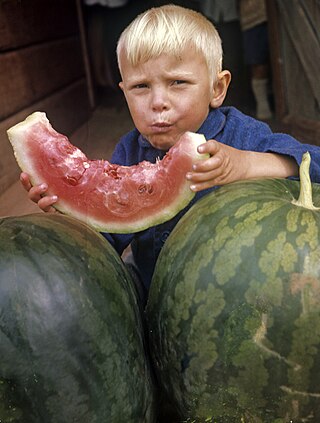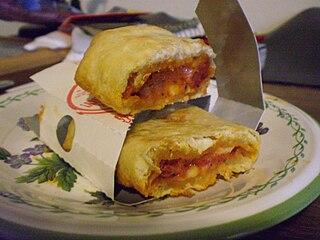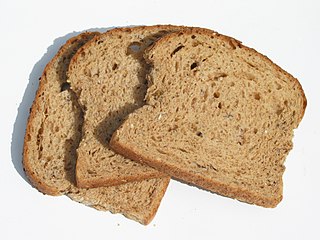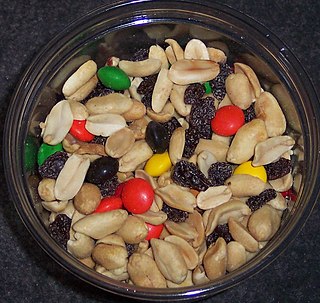
A microwave oven or simply microwave is an electric oven that heats and cooks food by exposing it to electromagnetic radiation in the microwave frequency range. This induces polar molecules in the food to vibrate and produce thermal energy in a process known as dielectric heating. Microwave ovens heat foods quickly and efficiently because excitation is fairly uniform in the outer 25–38 mm(1–1.5 inches) of a homogeneous, high-water-content food item.

Cornbread is a quick bread made with cornmeal, associated with the cuisine of the Southern United States, with origins in Native American cuisine. It is an example of batter bread. Dumplings and pancakes made with finely ground cornmeal are staple foods of the Hopi people in Arizona. The Hidatsa people of the Upper Midwest call baked cornbread naktsi, while the Choctaw people of the Southeast call it bvnaha. The Cherokee and Seneca tribes enrich the basic batter, adding chestnuts, sunflower seeds, apples, or berries, and sometimes combine it with beans or potatoes. Modern versions of cornbread are usually leavened by baking powder.

A crouton is a piece of toasted or fried bread, normally cubed and seasoned. Croutons are used to add texture and flavor to salads—notably the Caesar salad— as an accompaniment to soups and stews, or eaten as a snack food.

An oven is a tool that is used to expose materials to a hot environment. Ovens contain a hollow chamber and provide a means of heating the chamber in a controlled way. In use since antiquity, they have been used to accomplish a wide variety of tasks requiring controlled heating. Because they are used for a variety of purposes, there are many different types of ovens. These types differ depending on their intended purpose and based upon how they generate heat.

A convection oven is an oven that has fans to circulate air around food to create an evenly heated environment. In an oven without a fan, natural convection circulates hot air unevenly, so that it will be cooler at the bottom and hotter at the top than in the middle. Fan ovens cook food faster, and are also used in non-food, industrial applications. Small countertop convection ovens for household use are often marketed as air fryers.

Breadcrumbs, also known as breading, consist of crumbled bread of varying dryness, sometimes with seasonings added, used for breading or crumbing foods, topping casseroles, stuffing poultry, thickening stews, adding inexpensive bulk to soups, meatloaves and similar foods, and making a crisp and crunchy covering for fried foods, especially breaded cutlets like tonkatsu and schnitzel. The Japanese variety of breadcrumbs is called "panko".

A bacon sandwich is a sandwich of cooked bacon. It may be spread with butter, and may be seasoned with brown sauce or tomato ketchup. It is generally served hot. In some establishments the sandwich will be made from bread toasted on only one side, while other establishments serve it on a similar roll as is used for hamburgers.

Mouthfeel refers to the physical sensations in the mouth caused by food or drink, making it distinct from taste. It is a fundamental sensory attribute which, along with taste and smell, determines the overall flavor of a food item. Mouthfeel is also sometimes referred to as texture.

A susceptor is a material used for its ability to absorb electromagnetic energy and convert it to heat. The electromagnetic energy is typically radiofrequency or microwave radiation used in industrial heating processes. In the consumer world, many microwave cooking tools as well as some disposable cooking vessels used with induction heating employ susceptors.

Fried onions are slices of onions that are either pan fried (sautéed) or deep fried — and consumed as a popular snack food, garnish, or vegetable accompaniment to various recipes.

Staling, or "going stale", is a chemical and physical process in bread and similar foods that reduces their palatability. Stale bread is dry and hard, making it suitable for different culinary uses from fresh bread. Countermeasures and destaling techniques may reduce staling.

Crunchiness is the sensation of muffled grinding of a foodstuff. Crunchiness differs from crispness in that a crisp item is quickly atomized, while a crunchy one offers sustained, granular resistance to jaw action. While crispness is difficult to maintain, crunchiness is difficult to overcome.

Scorched rice, also known as crunchy rice, is a thin crust of slightly browned rice at the bottom of the cooking pot. It is produced during the cooking of rice over direct heat from a flame.

Shallow frying is a hot oil-based cooking technique. It is typically used to prepare portion-sized cuts of meat, fish, potatoes and patties such as fritters. Shallow frying can also be used to cook vegetables.

Triple-cooked chips are a type of chips developed by the English chef Heston Blumenthal. The chips are first simmered, then cooled and drained using a sous-vide technique or by freezing; deep fried at 130 °C (266 °F) and cooled again; and finally deep-fried again at 180 °C (356 °F). The result is what Blumenthal calls "chips with a glass-like crust and a soft, fluffy centre".

Puffcorn or corn puffs are puffed or extruded corn snacks made with corn meal, which can be baked or fried.

Apple chips are chips or crisps that are prepared using apples. When stale, apple chips become drier and crispier. Contrary to modern belief, apple chips do not become chewier when stale, only harder. Apple chips may be fried, deep fried, vacuum fried, dehydrated or baked. Apple chips may have a dense and crispy texture or may be puffed, yet still crispy. Microwave vacuum-drying may be used to prepare apple chips with a puffy and crispy texture. They may be seasoned with cinnamon and sweetened with confectioners sugar. Apple chips may be consumed as a snack food, and may be accompanied by various dips and other foods. Apple chips are mass-produced in the United States.

Pork rind is the culinary term for the skin of a pig. It can be used in many different ways.

Prawn crackers are a deep-fried snack made from starch and prawn. They are a common snack food in Southeast Asian cuisine, but they are most closely associated with Indonesia. They have also been adapted into East Asian cuisines, where the similar Japanese kappa ebisen (かっぱえびせん) and Korean saeukkang are popular snacks.

A snack is a small portion of food generally eaten between meals. A snack is often less than 200 calories, but this can vary. Snacks come in a variety of forms including packaged snack foods and other processed foods, as well as items made from fresh ingredients at home.




















